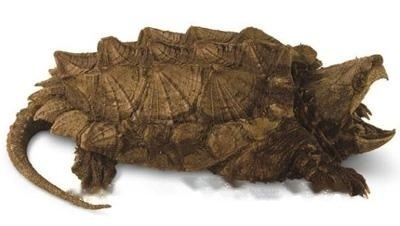
Snapping turtle
Real snapping turtles look like crocodiles fish, Set turtle and crocodile in one, so called true snapping turtle. Its head is relatively thick and cannot be completely retracted in
English name: Tortoise
Personality: timid and scared
Lifespan: 30-50 years
Disease: refusal to eat
The maple leaf turtle is what we often call the ground tortoise. Because of its appearance like a maple leaf, it has this name. The ground tortoise also has a wild existence in my country, but it belongs to national protection. Animals, and tortoises are notoriously difficult to raise, so it is recommended that novices do not try it lightly.
Ground turtles are small, with an adult carapace only 120 mm long and 78 mm wide. The head is light brown, the head is small, the back is smooth, the upper beak is hooked and curved, the eyes are large and protruding, and there are light yellow longitudinal stripes from the rostral side along the eye to the neck side. The carapace is golden-yellow or orange-yellow, with three ridges in the center and 12 teeth on the front and rear edges, so it is called “twelve-lobed turtle”. The plastron is brown and black, with light yellow markings on both sides. The hind limbs are light brown with red or black markings, webbed fingers and toes, and a short tail.
Chinese name: Maple Leaf Turtle
Chinese aliases: ground turtle, black-breasted leaf turtle, long-tailed mountain turtle, mud turtle, twelve-leafed turtle
English name: Black-breatsed Leaf Turtle
Binomial method: spengleri
Kingdom: Animal Kingdom
Door: Chordate
Subphylum: Vertebrate Subphylum
Class: Reptiles
Order: Turtles
Suborder: Suborder Divergeus
Family: Turtle family
Subfamily: Freshwater Turtles
Genus: Turtle
Species: Maple Leaf Turtle
Distribution: China Yunnan West Yunnan, Guangxi Guilin, Guangdong, Hunan, Hainan, Vietnam, Indonesia and other places
Price: Relatively cheap, but difficult to raise, generally about 100 yuan for smaller ones.
The maple turtle is a relatively common turtle in my country. It has a strange appearance and is easy to identify. The carapace is long but not wide. He looked more like a maple leaf.
The maple turtle is a semi-aquatic turtle with a small body, with an adult carapace only 120 mm long and 78 mm wide. The head is light brown, the head is small, the back is smooth, the upper beak is hooked and curved, the eyes are large and protruding, and there are light yellow longitudinal stripes from the rostral side along the eye to the neck side. The carapace is golden-yellow or orange-yellow, with three ridges in the center and 12 teeth on the front and rear edges, so it is called “twelve-lobed turtle”. Because the shape of the carapace is like a maple leaf, it is also called “Maple Leaf Turtle”. Its plastron is brown and black, so it is also called “black-breasted leaf turtle”.
The plastron is brown-black with light yellow markings on both sides, and the bridge of the carapace is obvious, and the dorsal and plastron are connected by bone sutures. The hind limbs are light brown with red or black markings, and webbed fingers and toes. The plastron of the female turtle is flat, the tail is short, and the cloacal hole is closer to the rear edge of the plastron; the plastron of the male turtle is concave in the center, the tail is long and thick, and the cloacal hole is far from the rear edge of the plastron.
Diet
The diet of wild ground turtles is not documented. Under artificial feeding conditions, the feeding habits of each ground turtle are different, and the feeding habits are determined by the wild ecological environment in which the tortoise lives. Most turtles eat mealworms, earthworms, tomatoes, lean pork, and cucumbers.
The tortoise likes to eat all kinds of live bugs. For example earthworms, crickets, mealworms, etc.
breeding
Oviparous, spawning from June to August.
Identification of male and female: the plastron of female turtles is flat, the tail is short, and the cloaca is closer to the rear edge of the plastron; the plastron of male turtles is concave in the center, and the tail is long and thick , the cloacal foramen is far from the posterior edge of the plastron.
After the maple tortoise has successfully started to eat, feeding it will become simple, because this shows that the maple turtle is already familiar with the environment and enters the state, as long as he is provided with a reasonable diet at this time , you can basically pass the dangerous period of feeding, and will like to be close to people more and more in the future.
I. Choice of food
Maple tortoises like to eat all kinds of live bugs.For example earthworms, crickets, mealworms, etc. Any small insects or animals that can move can be fed almost all, but tadpoles, brine shrimp, and turtle food can be avoided. Net owners usually supply crickets as their staple food, and occasionally feed silkworms, barley worms, or remove the hind legs. Grasshoppers, and small fish, cat food, newborn mice with unopened eyes And so on, and occasionally supply papaya bananas, oranges, grapefruit or mango, or other sweet and fragrant fruits, as for vegetables, you can save.
2. Feeding precautions
Provide calcium powder and vitamin supplements once every two weeks, and sprinkle calcium powder and vitamin supplements on food. Feeding time is mostly in the evening or evening, because it is more active during this time and has a better appetite. In terms of food intake, each maple turtle can usually eat about 2-4 crickets and two barley worms at a time, and it is fed five times a week. There are also hatchlings who like to drag their food into the water to eat, and drink or soak in the pool in the morning and noon, so the owner should change the water every day.